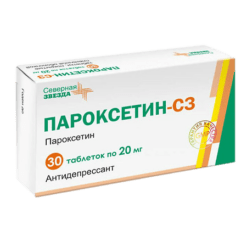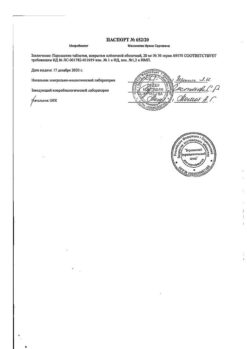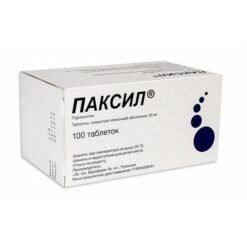No products in the cart.
Paroxetine, 20 mg 30 pcs
€10.15 €8.88
Out of stock
(E-mail when Stock is available)
Description
Pharmacotherapeutic group: antidepressant.
ATX code: N06AB05
PHARMACOLOGICAL PROPERTIES
Pharmacodynamics
Mechanism of action
Paroxetine is a potent and selective inhibitor of 5-hydroxytryptamine (5-HT, serotonin) reuptake. Its antidepressant activity and effectiveness in treating obsessive-compulsive (OCD) and panic disorder are believed to be due to specific inhibition of serotonin reuptake in brain neurons. Paroxetine differs chemically from tricyclic, tetracyclic and other known antidepressants.
Paroxetine has weak affinity to muscarinic cholinergic receptors, and animal studies have shown that it has only weak anticholinergic properties.
Consistent with the selective action of paroxetine, in vitro studies have shown that, unlike tricyclic antidepressants, it has weak affinity for α1-, α2- and β-adrenoreceptors as well as dopamine (D2), 5-HT1 -like, 5HT2- and histamine (H1) receptors. This lack of interaction with postsynaptic receptors in vitro is confirmed by the results of in vivo studies, which demonstrated that paroxetine has no ability to suppress the central nervous system (CNS) and cause arterial hypotension.
Pharmacodynamic effects
Paroxetine does not impair psychomotor functions and does not enhance the CNS suppressive effect of ethanol. Like other selective serotonin reuptake inhibitors, paroxetine causes symptoms of overstimulation of 5-NT receptors when administered to animals that previously received monoamine oxidase inhibitors (MAOIs) or tryptophan. Studies of behavior and EEG changes have demonstrated that paroxetine produces weak activating effects at doses greater than those required to inhibit serotonin reuptake. Its activating properties are not “amphetamine-like” in nature.
Animal studies have shown that paroxetine has no effect on the cardiovascular system. In healthy individuals, paroxetine does not cause clinically significant changes in blood pressure, heart rate and ECG.
Studies have shown that unlike antidepressants, which inhibit norepinephrine reuptake, paroxetine has much less ability to inhibit the antihypertensive effects of guanethidine.
Pharmacokinetics
Absorption
After oral administration, paroxetine is well absorbed and undergoes first-pass metabolism. Due to first-pass metabolism, a smaller amount of paroxetine enters the systemic bloodstream than is absorbed from the gastrointestinal tract. As the amount of paroxetine in the body increases with a single high-dose administration or with multiple conventional doses, there is partial saturation of the metabolic “first-pass” pathway and a decrease in the clearance of paroxetine from plasma. This results in a disproportionate increase in plasma concentrations of paroxetine. Therefore, its pharmacokinetic parameters are not stable, resulting in nonlinear kinetics.
It should be noted, however, that nonlinearity is usually weak and is observed only in those patients in whom low plasma levels of paroxetine are achieved at low doses of the drug. Stable plasma concentrations are reached 7-14 days after initiation of paroxetine treatment; its pharmacokinetic parameters are unlikely to change during long-term therapy.
Distribution
Paroxetine is widely distributed in tissues, and pharmacokinetic calculations indicate that only 1% of the total paroxetine present in the body remains in plasma. At therapeutic concentrations, approximately 95% of the plasma paroxetine present is bound to proteins.
No correlation has been found between paroxetine plasma concentrations and its clinical effects (i.e., adverse reactions and efficacy).
Paroxetine has been found to penetrate in small amounts into the breast milk of women, as well as into the embryos and fetuses of
laboratory animals.
Metabolism
The main metabolites of paroxetine are polar and conjugated oxidation and methylation products that are easily eliminated from the body. Given the relative lack of pharmacological activity of these metabolites, it can be argued that they do not affect the therapeutic effects of paroxetine.
Metabolism does not impair the ability of paroxetine to selectively inhibit serotonin reuptake.
Elimination
Less than 2% of the administered dose is excreted as unchanged paroxetine in the urine, whereas metabolite excretion reaches 64% of the dose. About 36% of the dose is excreted in the feces, probably entering it with the bile; fecal excretion of unchanged paroxetine is less than 1% of the dose. Thus, paroxetine is eliminated almost entirely by metabolism.
The excretion of metabolites is biphasic: first as a result of “first pass” metabolism, then controlled by systemic elimination of paroxetine.
The half-life of paroxetine varies, but is usually about 1 day (16-24 h).
Indications
Indications
Depression
Depression of all types, including reactive and severe depression, as well as depression accompanied by anxiety.
In the treatment of depressive disorders, paroxetine is approximately as effective as tricyclic antidepressants. There is evidence that paroxetine may provide good results in patients in whom standard antidepressant therapy has failed.
Taking paroxetine in the morning does not adversely affect the quality or duration of sleep. In addition, sleep may improve as paroxetine treatment works.
When using short-acting hypnotics in combination with antidepressants, no additional side effects occurred. In the first few weeks of therapy, paroxetine is effective in reducing symptoms of depression and suicidal ideation.
Results from studies in which patients took paroxetine for up to 1 year showed that the drug was effective in preventing relapses of depression.
Obsessive-compulsive disorder
Paroxetine is effective in the treatment of obsessive-compulsive disorder (OCD), incl. and as a means of maintenance and preventive therapy. In addition, paroxetine was effective in preventing relapses of OCD.
Panic disorder
Paroxetine is effective in the treatment of panic disorder with and without agoraphobia, incl. as a means of maintenance and preventive therapy.
It has been established that in the treatment of panic disorder, the combination of paroxetine and cognitive behavioral therapy is significantly more effective than the isolated use of cognitive behavioral therapy.
In addition, paroxetine was effective in preventing relapses of panic disorder.
Social phobia
Paroxetine is an effective treatment for social phobia, incl. and as long-term maintenance and preventive therapy.
Generalized anxiety disorder
Paroxetine is effective for generalized anxiety disorder, incl. and as long-term maintenance and preventive therapy. Paroxetine is also effective in preventing relapses in this disorder.
Post-traumatic stress disorder.
Paroxetine is effective in the treatment of post-traumatic stress disorder.
Pharmacological effect
Pharmacological effect
Pharmacotherapeutic group: antidepressant.
ATX code: N06AB05
PHARMACOLOGICAL PROPERTIES
Pharmacodynamics
Mechanism of action
Paroxetine is a potent and selective 5-hydroxytryptamine (5-HT, serotonin) reuptake inhibitor. It is generally accepted that its antidepressant activity and effectiveness in the treatment of obsessive-compulsive (OCD) and panic disorder is due to the specific inhibition of serotonin reuptake in brain neurons. In its chemical structure, paroxetine differs from tricyclic, tetracyclic and other known antidepressants.
Paroxetine has weak affinity for muscarinic cholinergic receptors, and animal studies have shown that it has only weak anticholinergic properties.
Consistent with the selective action of paroxetine, in vitro studies have shown that, unlike tricyclic antidepressants, it has weak affinity for α1-, α2- and β-adrenergic receptors, as well as dopamine (D2), 5-HT1-like, 5HT2- and histamine (H1) receptors. This lack of interaction with postsynaptic receptors in vitro is confirmed by the results of in vivo studies, which demonstrated the absence of paroxetine’s ability to depress the central nervous system (CNS) and cause arterial hypotension.
Pharmacodynamic effects
Paroxetine does not impair psychomotor functions and does not enhance the inhibitory effect of ethanol on the central nervous system. Like other selective serotonin reuptake inhibitors, paroxetine causes symptoms of excessive stimulation of 5-HT receptors when administered to animals that have previously received monoamine oxidase inhibitors (MAOIs) or tryptophan. Behavioral and EEG studies have demonstrated that paroxetine produces weak activating effects at doses greater than those required to inhibit serotonin reuptake. Its activating properties are not “amphetamine-like” in nature.
Animal studies have shown that paroxetine does not affect the cardiovascular system. In healthy individuals, paroxetine does not cause clinically significant changes in blood pressure, heart rate and ECG.
Studies have shown that, unlike antidepressants that inhibit norepinephrine reuptake, paroxetine has much less ability to inhibit the antihypertensive effects of guanethidine.
Pharmacokinetics
Absorption
After oral administration, paroxetine is well absorbed and undergoes first-pass metabolism. Due to first-pass metabolism, less paroxetine enters the systemic circulation than is absorbed from the gastrointestinal tract. As the amount of paroxetine in the body increases, with a single dose of large doses or with multiple doses of usual doses, partial saturation of the first-pass metabolic pathway occurs and the clearance of paroxetine from plasma decreases. This results in a disproportionate increase in paroxetine plasma concentrations. Therefore, its pharmacokinetic parameters are not stable, resulting in nonlinear kinetics.
It should be noted, however, that nonlinearity is usually mild and is observed only in those patients who achieve low plasma levels of paroxetine while taking low doses of the drug. Steady-state plasma concentrations are achieved 7-14 days after initiation of treatment with paroxetine, and its pharmacokinetic parameters are likely to remain unchanged during long-term therapy.
Distribution
Paroxetine is widely distributed in tissues, and pharmacokinetic calculations show that only 1% of the total amount of paroxetine present in the body remains in the plasma. At therapeutic concentrations, approximately 95% of paroxetine in plasma is protein bound.
No correlation was found between paroxetine plasma concentrations and its clinical effect (i.e., adverse reactions and efficacy).
It has been established that paroxetine in small quantities penetrates into the breast milk of women, as well as into embryos and fetuses
laboratory animals.
Metabolism
The main metabolites of paroxetine are polar and conjugated oxidation and methylation products, which are easily eliminated from the body. Given the relative lack of pharmacological activity of these metabolites, it can be argued that they do not affect the therapeutic effects of paroxetine.
Metabolism does not impair the ability of paroxetine to selectively inhibit serotonin reuptake.
Elimination
Less than 2% of the dose taken is excreted in the urine as unchanged paroxetine, while the excretion of metabolites reaches 64% of the dose. About 36% of the dose is excreted in the feces, probably in the bile; fecal excretion of unchanged paroxetine is less than 1% of the dose. Thus, paroxetine is eliminated almost entirely through metabolism.
Excretion of metabolites is biphasic: initially the result of first-pass metabolism, then controlled by the systemic elimination of paroxetine.
The half-life of paroxetine varies, but is usually about 1 day (16-24 hours).
Active ingredient
Active ingredient
Paroxetine
Composition
Composition
Active substance:
paroxetine hydrochloride hemihydrate – 22.77 mg, in terms of paroxetine – 20.00 mg.
Excipients: calcium hydrogen phosphate dihydrate – 209.73 mg; microcrystalline cellulose – 60.00 mg; sodium carboxymethyl starch – 3.00 mg; colloidal silicon dioxide – 1.50 mg; magnesium stearate – 3.00 mg.
Shell composition: hypromellose – 4.54 mg; macrogol-4000 – 1.06 mg; titanium dioxide – 2.40 mg
Pregnancy
Pregnancy
Fertility
According to animal studies, paroxetine may affect the quality of sperm.
Data from in vitro human studies may indicate some effect on sperm quality, but human case reports with some SSRI inhibitor drugs (including paroxetine) have shown that the effect on sperm quality is reversible.
To date, no effects on human fertility have been observed.
Pregnancy
Animal studies have not revealed paroxetine to have teratogenic or selective embryotoxic activity.
Epidemiological studies of pregnancy outcomes with antidepressant use in the first trimester have found an increased risk of congenital anomalies, particularly cardiovascular abnormalities (eg, ventricular septal defects and atrial septal defects), associated with paroxetine use. The reported incidence of cardiovascular defects with paroxetine use during pregnancy is approximately 1/50, whereas the expected incidence of such defects in the general population is approximately 1/100 births. When prescribing paroxetine, alternative treatment options should be considered in women who are pregnant or planning pregnancy.
Paroxetine should only be prescribed if its potential benefit outweighs the potential risk. If a decision is made to discontinue treatment with paroxetine during pregnancy, the physician should follow the recommendations in the sections “Dosage and Administration” – “Discontinuation of Paroxetine” and “Special Instructions” – “Symptoms that may occur when stopping treatment with paroxetine in adults.”
There are reports of preterm birth in women who received paroxetine or other SSRI drugs during pregnancy, but a cause-and-effect relationship between taking these drugs and preterm birth has not been established. It is necessary to monitor the health of those newborns whose mothers took paroxetine during late pregnancy, as there are reports of complications in newborns exposed to paroxetine or other SSRI drugs in the third trimester of pregnancy. However, a cause-and-effect relationship between these complications and this drug therapy has not been confirmed. Clinical complications reported included: respiratory distress, cyanosis, apnea, seizures, temperature instability, feeding difficulties, vomiting, hypoglycemia, hypertension, hypotension, hyperreflexia, tremor, hyperexcitability syndrome, irritability, lethargy, constant crying and drowsiness. In some reports, symptoms have been described as neonatal manifestations of withdrawal syndrome. In most cases, the described complications occurred immediately after delivery or shortly thereafter (<24 hours). According to epidemiological studies, taking SSRI drugs (including paroxetine) during pregnancy, especially in later stages, is associated with an increased risk of developing persistent pulmonary hypertension in newborns.
An increased risk is observed in children born to mothers who took SSRI drugs in late pregnancy, and is 4-5 times higher than observed in the general population (1-2 per 1000 pregnancies).
Results from animal studies have shown reproductive toxicity, but no direct adverse effects on pregnancy, embryonic and fetal development, childbirth or postnatal development have been demonstrated.
Breastfeeding period
Minor amounts of paroxetine pass into breast milk. In published studies in breastfed children, paroxetine concentrations were undetectable (< 2 ng/ml) or very low (< 4 ng/ml).
There were no signs of drug exposure in children. However, paroxetine should not be taken during breastfeeding unless the benefits to the mother outweigh the potential risks to the baby.
Contraindications
Contraindications
hypersensitivity to paroxetine and any other component included in the drug;
paroxetine is contraindicated in combination with monoamine oxidase inhibitors (MAOIs). In exceptional cases, linezolid (an antibiotic that is a reversible, non-selective MAOI) may be combined with paroxetine, provided that acceptable alternatives to linezolid treatment are not available and the potential benefit of linezolid outweighs the risks of serotonin syndrome or neuroleptic malignant syndrome reactions in a particular patient.
Equipment to closely monitor symptoms of serotonin syndrome and monitor blood pressure should be available. Treatment with paroxetine is allowed:
– 2 weeks after stopping treatment with irreversible MAOIs or
– at least 24 hours after stopping treatment with reversible MAOIs (e.g.
moclobemide, linezolid, methylthioninium chloride (methylene blue)),
– at least 1 week should elapse between stopping paroxetine and starting therapy
any MAOI;
combined use with thioridazine. Paroxetine should not be used in combination with thioridazine because, like other drugs that inhibit the activity of the hepatic isoenzyme CYP2D6, paroxetine may increase plasma concentrations of thioridazine, which may lead to prolongation of the QTc interval and associated potentially life-threatening torsade de pointes (TdP) and sudden death;
combined use with pimozide;
use in children and adolescents under 18 years of age. Controlled clinical trials of paroxetine in the treatment of depression in children and adolescents have not proven its effectiveness, so the drug is not indicated for the treatment of this age group. The safety and effectiveness of paroxetine have not been studied when used in younger patients (under 7 years of age).
Side Effects
Side Effects
The frequency and intensity of some of the adverse reactions of paroxetine listed below may decrease with continued treatment, and such reactions usually do not require discontinuation of the drug. The adverse reactions presented below are listed according to the damage to organs and organ systems and the frequency of occurrence.
The frequency of occurrence is defined as follows: very common (≥1/10), common (≥1/100, ≥1/10), uncommon (≥1/1000, ≥1/100), rare (≥1/10000, ≥1/1000), very rare (≥1/10000), including isolated cases, and the frequency is unknown. The incidence of common and uncommon adverse reactions was determined based on pooled drug safety data in more than 8000 patients participating in clinical trials, and was calculated by the difference between the incidence of adverse reactions in the paroxetine group and in the placebo group. The incidence of rare and very rare adverse reactions was determined based on post-marketing data and relates to the frequency of reports of such reactions rather than the true frequency of the reactions themselves.
From the hematopoietic system: infrequently – abnormal bleeding, mainly hemorrhage into the skin and mucous membranes (most often – bruises); very rarely – thrombocytopenia.
From the immune system: very rarely – allergic reactions (including anaphylactoid reactions and angioedema).
From the endocrine system: very rarely – syndrome of impaired secretion of antidiuretic hormone. Metabolic and nutritional disorders: often – decreased appetite, increased cholesterol concentration; rarely – hyponatremia. Hyponatremia occurs predominantly in elderly patients and may be due to the syndrome of impaired secretion of antidiuretic hormone.
Mental disorders: often – drowsiness, insomnia, agitation, unusual dreams (including nightmares); infrequently – confusion, hallucinations; rarely – manic reactions, anxiety, depersonalization, panic attacks, akathisia; frequency unknown – suicidal thoughts, suicidal behavior.
Cases of suicidal ideation and suicidal behavior have been reported during treatment with paroxetine or early after cessation of treatment. These symptoms may also be due to the disease itself.
From the nervous system: often – dizziness, tremor, headache, impaired concentration; uncommon – extrapyramidal disorders; rarely – seizures, restless legs syndrome; very rarely – serotonin syndrome (symptoms may include agitation, confusion, increased sweating, hallucinations, hyperreflexia, myoclonus, tachycardia with trembling and tremor). Extrapyramidal symptoms, including orofacial dystonia, have been reported infrequently in patients with motor impairment or those receiving antipsychotics.
From the side of the organ of vision: often – blurred vision; infrequently – mydriasis; very rarely – acute glaucoma.
On the part of the organ of hearing and balance: frequency unknown – tinnitus.
From the cardiovascular system: infrequently – sinus tachycardia, postural hypotension, short-term increase and decrease in blood pressure. Transient increases and decreases in blood pressure have been reported following treatment with paroxetine, usually in patients with pre-existing hypertension or anxiety; rarely – bradycardia.
From the respiratory system: often – yawning.
From the gastrointestinal tract: very often – nausea; often – constipation, diarrhea, vomiting, dry mouth; very rarely – gastrointestinal bleeding.
From the liver and biliary tract: rarely – increased activity of liver enzymes; very rarely – hepatitis, sometimes accompanied by jaundice and/or liver failure.
Post-marketing reports of liver adverse reactions (such as hepatitis, sometimes accompanied by jaundice and/or liver failure) are very rare. The question of the advisability of stopping treatment with paroxetine must be decided in cases where there is a prolonged increase in liver function tests.
From the skin and subcutaneous tissues: often – increased sweating; uncommon – skin rashes, itching; very rarely – photosensitivity reactions, severe skin reactions (including erythema multiforme, Stevens-Johnson syndrome and toxic epidermal necrolysis), urticaria.
From the urinary system: infrequently – urinary retention, urinary incontinence.
From the reproductive system and mammary glands: very often – sexual dysfunction; rarely – hyperprolactinemia, galactorrhea, menstrual irregularities (including menorrhagia, metrorrhagia and amenorrhea); very rarely – priapism.
From the musculoskeletal system: rarely – arthalgia, myalgia. Epidemiological studies, mainly conducted in patients aged 50 years and older, have shown an increased risk of bone fractures in patients receiving SSRIs and tricyclic antidepressants. The mechanism leading to this risk is unknown.
Other: often – asthenia, weight gain; very rarely – peripheral edema.
Symptoms that occur when stopping treatment with paroxetine: often – dizziness, sensory disturbances, sleep disturbances, anxiety, headache; uncommon – agitation, nausea, tremor, confusion, increased sweating, diarrhea, irritability.
Abruptly stopping the drug causes withdrawal syndrome. As with the withdrawal of many psychotropic drugs, stopping treatment with paroxetine (especially abruptly) may cause symptoms such as dizziness, sensory disturbances (including paresthesia, electrical sensations and tinnitus), sleep disturbances (including vivid dreams), agitation or anxiety, nausea, headache, tremor, confusion, diarrhea, increased sweating, palpitations, emotional lability, irritability, visual disturbances. In most patients, these symptoms are mild or moderate and resolve spontaneously. No patient group is known to be at increased risk for these symptoms; therefore, if treatment with paroxetine is no longer necessary, its dose should be reduced slowly until the drug is completely discontinued.
Interaction
Interaction
Serotonergic drugs
The use of paroxetine, like other SSRI drugs, concomitantly with serotonergic drugs (including L-tryptophan, triptans, tramadol, SSRI drugs, fentanyl, lithium and herbal products containing St. John’s wort) may cause 5-HT-related effects (serotonin syndrome), caution and close clinical monitoring are required.
The simultaneous use of paroxetine with MAO inhibitors (including linezolid, an antibiotic that transforms into a non-selective MAO inhibitor, and methylthioninium chloride (methylene blue)) is contraindicated.
Pimozide
In a study of the co-administration of paroxetine and pimozide at a single low dose (2 mg), an increase in pimozide levels was reported. This fact is explained by the known property of paroxetine to inhibit the CYP2D6 system. Due to the narrow therapeutic index of pimozide and its known ability to prolong the QT interval, concomitant use of pimozide and paroxetine is contraindicated.
Enzymes involved in drug metabolism
The metabolism and pharmacokinetics of paroxetine may be altered by induction or inhibition of enzymes involved in drug metabolism.
When using paroxetine concomitantly with inhibitors of enzymes involved in drug metabolism, the advisability of using a dose of paroxetine that is at the lower end of the therapeutic dose range should be assessed. The initial dose of paroxetine does not need to be adjusted if it is used concomitantly with a drug that is a known inducer of enzymes involved in drug metabolism (for example, carbamazepine, rifampicin, phenobarbital, phenytoin). Any subsequent dose adjustment of paroxetine should be determined by its clinical effects (tolerability and efficacy).
Fosamprenavir/ritonavir
Concomitant use of fosamprenavir/ritonavir with paroxetine resulted in a significant decrease in paroxetine plasma concentrations. Plasma concentrations of fosamprenavir/ritonavir when co-administered with paroxetine were similar to control values from other studies, indicating that paroxetine does not have a significant effect on the metabolism of fosamprenavir/ritonavir. There are no data on the effects of long-term co-administration of paroxetine with fosamprenavir/ritonavir. Any subsequent dose adjustment of paroxetine should be determined by its clinical effect (tolerability and efficacy).
Procyclidine
Daily administration of paroxetine significantly increases the concentration of procyclidine in the blood plasma. If anticholinergic effects occur, the dose of procyclidine should be reduced.
Anticonvulsants
The simultaneous use of paroxetine and anticonvulsants (carbamazepine, phenytoin, sodium valproate) does not affect their pharmacokinetic and pharmacodynamic profiles in patients with epilepsy.
Neuromuscular blockers
SSRI drugs can reduce plasma cholinesterase activity, which leads to an increase in the duration of the neuromuscular blocking effect of mivacurium and suxamethonium.
The ability of paroxetine to inhibit the CYP2D6 isoenzyme
Like other antidepressants, including other SSRI drugs, paroxetine inhibits the liver enzyme CYP2D6, which belongs to the cytochrome P450 system. Inhibition of the CYP2D6 enzyme may lead to increased plasma concentrations of concomitantly used drugs that are metabolized by this enzyme. These drugs include some tricyclic antidepressants (eg, amitriptyline, nortriptyline, imipramine and desipramine), phenothiazine antipsychotics (perphenazine and thioridazine), risperidone, atomoxetine, some class 1 C antiarrhythmics (eg, propafenone and flecainide), and metoprolol. It is not recommended to use paroxetine in combination with metoprolol for heart failure, due to the narrow therapeutic index of metoprolol for this indication.
Irreversible inhibition of the CYP2D6 system by paroxetine may lead to a decrease in the concentration of its active metabolite, endoxifen, in the blood plasma, and as a result, reduce the effectiveness of tamoxifen.
The ability of paroxetine to inhibit the CYP3A4 isoenzyme.
An in vivo interaction study with simultaneous use, under steady state conditions, of paroxetine and terfenadine, which is a substrate of the CYP3A4 isoenzyme, showed that paroxetine does not affect the pharmacokinetics of terfenadine. In a similar in vivo interaction study, no effect of paroxetine on the pharmacokinetics of alprazolam was found, and vice versa. Concomitant use of paroxetine with terfenadine, alprazolam and other drugs that serve as substrates of the CYP3A4 isoenzyme is unlikely to cause harm to the patient.
Clinical studies have shown that the absorption and pharmacokinetics of paroxetine are independent or practically independent (i.e., the existing dependence does not require dose changes) from food, antacids, digoxin, propranolol, alcohol (paroxetine does not enhance the negative effect of ethanol on psychomotor functions, however, it is not recommended to take paroxetine and alcohol at the same time).
Oral anticoagulants
Pharmacodynamic interactions may occur between paroxetine and oral anticoagulants. Concomitant use of paroxetine and oral anticoagulants may increase the activity of the anticoagulants and the risk of bleeding. Therefore, paroxetine should be used with caution in patients receiving oral anticoagulants.
NSAIDs, acetylsalicylic acid and other antiplatelet drugs
A pharmacodynamic interaction may occur between paroxetine and NSAIDs/acetylsalicylic acid. Concomitant use of paroxetine and NSAIDs/acetylsalicylic acid may increase the risk of bleeding.
Caution should be exercised when treating patients receiving SSRI drugs concomitantly with oral anticoagulants, with drugs that affect platelet function or increase the risk of bleeding (for example, atypical antipsychotics such as clozapine, phenothiazines, most tricyclic antidepressants, acetylsalicylic acid, NSAIDs, COX-2 inhibitors), as well as when treating patients with a history of bleeding disorders or conditions that may predispose to bleeding.
Overdose
Overdose
Objective and subjective symptoms
Available information regarding paroxetine overdose indicates a wide range of safety. In case of an overdose of paroxetine, in addition to the symptoms described in the “Side Effects” section, fever, changes in blood pressure, involuntary muscle contractions, anxiety and tachycardia are observed.
The patients’ condition usually returned to normal without serious consequences, even with single doses of up to 2000 mg. A number of reports have described symptoms such as coma and ECG changes,
Deaths have been very rare, usually in situations where patients were taking paroxetine with other psychotropic drugs or with alcohol.
Treatment
There is no specific antidote for paroxetine. Treatment should consist of the general measures used for overdose of any antidepressant. Supporting shown
therapy and frequent monitoring of basic physiological parameters. The patient should be treated according to the clinical picture or as recommended by the national poison control center.
Storage conditions
Storage conditions
In a place protected from light at a temperature not exceeding 25 ° C.
Keep out of the reach of children.
Shelf life
Shelf life
3 years. Do not use after expiration date
Manufacturer
Manufacturer
Ozon, Russia
Additional information
| Shelf life | 3 years. Do not use after the expiration date |
|---|---|
| Conditions of storage | Store in a dark place at a temperature not exceeding 25 °С. Keep out of reach of children. |
| Manufacturer | Ozon, Russia |
| Medication form | pills |
| Brand | Ozon |
Other forms…
Related products
Buy Paroxetine, 20 mg 30 pcs with delivery to USA, UK, Europe and over 120 other countries.





















